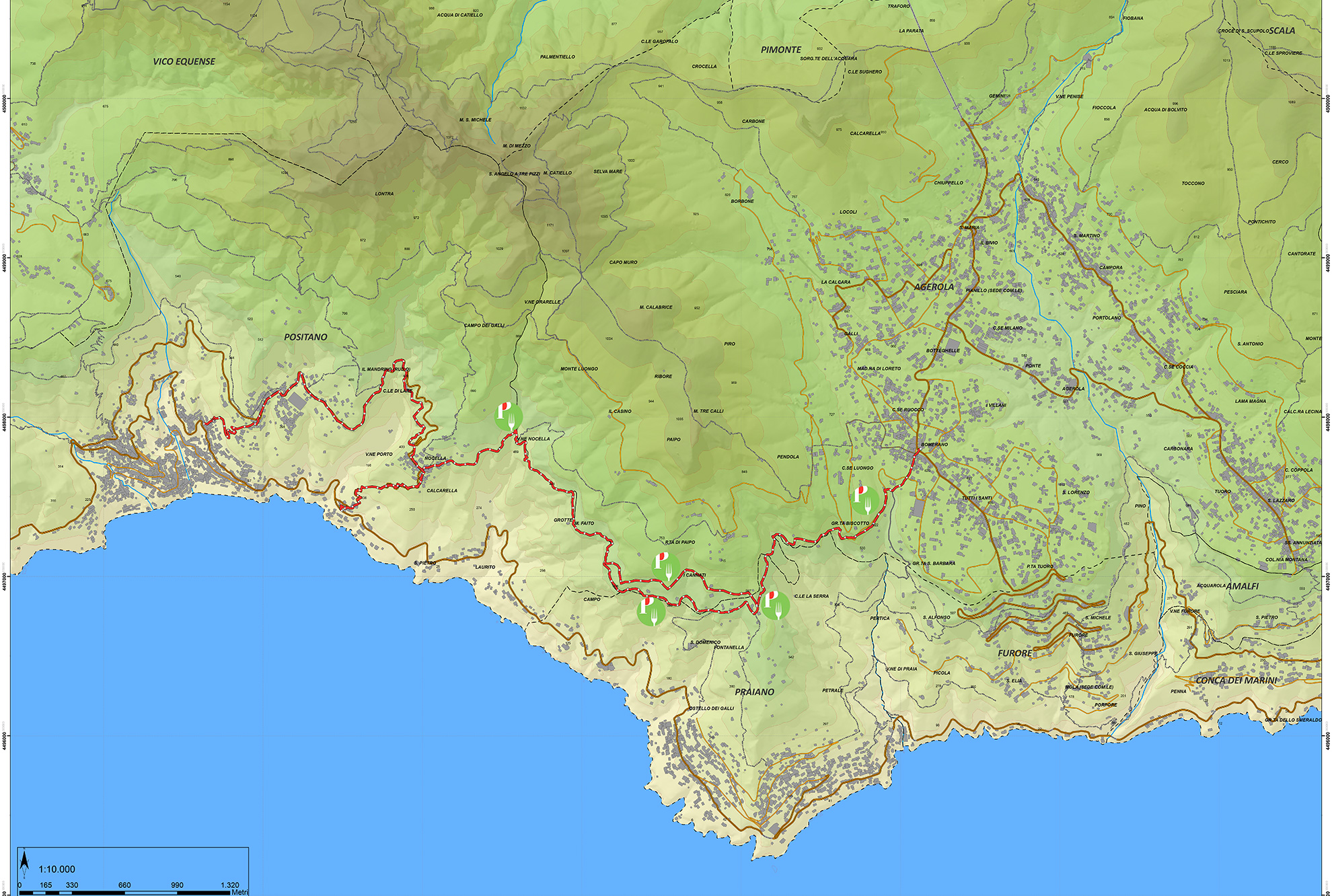Best hiking maps are crucial for any successful and safe outdoor adventure. Choosing the right map, whether paper or digital, can mean the difference between a memorable hike and a frustrating, even dangerous, experience. This guide delves into the various types of hiking maps available, their key features, and how to select and utilize them effectively for different hiking scenarios, from day trips to extended backpacking expeditions. We’ll explore the benefits and drawbacks of different map types, essential map reading skills, and safety considerations to ensure your journey is both enjoyable and responsible.
Understanding map scales, contour lines, and symbols is fundamental. We’ll also cover practical techniques for using a map and compass, integrating map apps with GPS devices, and preparing for unexpected situations. This comprehensive guide will empower you to navigate confidently and safely, making the most of your time on the trail.
Map Features and Information
Choosing the right hiking map is crucial for a safe and enjoyable experience. Understanding the map’s features and how to interpret them is paramount to successful navigation, especially in unfamiliar terrain. This section details essential map elements and provides practical guidance on using them effectively.
Essential Map Elements
Effective navigation relies on understanding key map elements. Contour lines illustrate the terrain’s shape by connecting points of equal elevation. Closely spaced contour lines indicate steep slopes, while widely spaced lines suggest gentler inclines. Elevation profiles, often found alongside the map or as a separate graphic, provide a visual representation of elevation changes along a specific route, helping hikers anticipate challenging ascents or descents. Symbols represent various features like trails, water sources, campsites, and points of interest. Familiarity with these symbols is essential for quick identification and route planning. For instance, a blue dashed line typically represents a stream, while a red solid line might denote a well-maintained trail. Understanding these visual cues ensures safe and efficient navigation.
Map Scales and Distance Estimation
Map scale is the ratio between the distance on the map and the corresponding distance on the ground. It’s typically expressed as a representative fraction (e.g., 1:25,000), meaning one unit on the map represents 25,000 of the same units on the ground. For example, with a 1:25,000 scale map, 1 centimeter on the map equates to 250 meters on the ground. Accurate distance estimation is crucial for planning hikes and monitoring progress. Using a ruler or the map’s scale bar, hikers can measure distances on the map and convert them to real-world distances using the scale ratio. For instance, if a trail measures 5 centimeters on a 1:25,000 map, the actual trail length is approximately 1250 meters (5 cm * 250 m/cm). This simple calculation allows hikers to estimate the time needed to complete a hike or determine if they have enough time to reach their destination before nightfall.
Map and Compass Navigation
Combining a map and compass provides a reliable method for accurate navigation, especially when visibility is poor or landmarks are scarce. The process involves several steps. First, orient the map by aligning it with the terrain. This is done by holding the map horizontally and turning it until prominent features on the map match their real-world counterparts. Next, locate your current position on the map using visual landmarks or by taking a bearing with the compass. Then, select your desired destination on the map and determine the bearing to it using the compass. Finally, walk along the determined bearing, regularly checking your position on the map to ensure you’re staying on course. For instance, imagine a hiker is at a trail junction marked on the map and needs to reach a mountain summit. After orienting the map, they use the compass to find the bearing to the summit. They then follow that bearing, periodically checking their location against the map and adjusting their course as needed, ensuring they reach the summit safely and efficiently. Regularly referencing both the map and compass throughout the hike helps to maintain accurate navigation and avoid getting lost.
Choosing the Right Map for a Hike
Selecting the appropriate hiking map is crucial for a safe and enjoyable experience. A poorly chosen map can lead to disorientation, unexpected challenges, and even dangerous situations. This section will guide you through the process of choosing the right map for your specific needs.
Factors to Consider When Selecting a Hiking Map
Choosing a hiking map involves careful consideration of several key factors. The suitability of a map is directly linked to the characteristics of your planned hike and your personal needs. Overlooking these details can significantly impact your hike’s success and safety.
- Trail Difficulty and Length: Maps designed for easy, short day hikes will likely lack the detail needed for challenging, multi-day backpacking trips. A map for a leisurely stroll through a park will differ greatly from one designed for navigating rugged mountain terrain. For instance, a map showing only major trails might be sufficient for a short, well-marked hike, but a more detailed topographic map would be essential for a longer, more challenging hike with less obvious trails.
- Scale and Detail: The map’s scale indicates the ratio between the map’s distance and the actual ground distance. Larger-scale maps (e.g., 1:24,000) show more detail but cover a smaller area, ideal for detailed navigation on a specific trail. Smaller-scale maps (e.g., 1:100,000) cover a larger area but show less detail, suitable for planning a longer trip or overview of a region. The level of detail should reflect the complexity of your hike.
- Environmental Conditions: Consider the terrain, elevation changes, and potential hazards. A map highlighting water sources is crucial for backpacking trips. Maps indicating potential hazards like steep cliffs, river crossings, or areas prone to flooding are essential for safety. For instance, a map highlighting avalanche zones is crucial for winter hiking in mountainous regions.
- Intended Use (Day Hike vs. Backpacking): A day hike map needs to provide clear trail markings and points of interest within a reasonable radius. A backpacking map requires more detail, showing water sources, campsites, and elevation changes over a wider area. A detailed topographic map is usually preferable for backpacking, whereas a simpler trail map may suffice for a short day hike.
Assessing the Reliability and Accuracy of a Hiking Map Source
The accuracy and reliability of your map source are paramount. Using an outdated or inaccurate map can lead to serious consequences. Several factors should be considered to ensure map quality.
- Publication Date: Always check the publication date. Trails can change, new trails are built, and existing ones may become impassable. A recent publication date significantly improves accuracy.
- Publisher Reputation: Reputable map publishers, such as national geographic agencies or well-established outdoor recreation companies, generally maintain higher standards of accuracy and detail. Researching the publisher’s reputation can give you confidence in the map’s reliability.
- Map Legend and Symbols: A clear and comprehensive legend is crucial. Ensure you understand the symbols used to represent trails, elevation, water sources, and other relevant features. Inconsistencies or unclear symbols can be a sign of a poorly made map.
- Comparison with Other Sources: If possible, compare information from multiple map sources (online maps, guidebooks, etc.) to verify the accuracy of the chosen map. Discrepancies between sources might indicate potential inaccuracies in one or more of the maps.
Using Hiking Maps Effectively
Successfully navigating a hike relies heavily on your ability to effectively use a hiking map. Understanding map orientation, route planning, and integrating technology are crucial skills for a safe and enjoyable outdoor experience. This section details practical techniques for maximizing the utility of your map, regardless of whether it’s a paper map or a digital application.
Map Orientation and Landmark Navigation
Proper map orientation is paramount. Begin by aligning the map’s north arrow with the true north direction. You can determine true north using a compass, aligning its needle with the north marking on the compass bezel, then rotating the map until its north arrow points in the same direction. Once oriented, identify prominent landmarks visible on the map, such as rivers, ridges, peaks, or trails. Compare these features with your surroundings. If you see a distinctive peak on the map and recognize it in the distance, you’ve successfully correlated your position on the map with your actual location. Continuously compare your observed landmarks with the map throughout your hike to maintain your bearing and correct any navigational drift. For example, if your map shows a stream crossing the trail 0.5 miles ahead, and you reach the stream sooner, you might be slightly off-course and need to adjust your path accordingly.
Route Planning and Marking on Paper Maps
Planning your route beforehand significantly enhances safety and enjoyment. Use a pencil to lightly trace your intended path on the map. This allows for easy adjustments if you encounter unexpected obstacles. Highlight key points like trail junctions, campsites, water sources, and potential hazards. Using different colored pencils can help categorize this information. For instance, a red line could denote your planned route, while blue could indicate water sources. A detailed, pre-planned route reduces the chances of getting lost and helps manage your time effectively. Consider factors like elevation changes and trail difficulty when planning your route. A well-marked paper map serves as a physical record of your intended journey, a backup plan should technology fail.
Map Apps and GPS Integration
Modern map applications offer significant advantages for hikers. These apps often integrate with GPS devices, providing real-time location data and navigational guidance. The advantages include precise location tracking, the ability to download offline maps for areas with limited or no cell service, and access to a wealth of trail information, including user reviews and elevation profiles. However, limitations exist. GPS signals can be weak or unreliable in dense forests or canyons, leading to inaccurate location readings. Battery life is another critical concern; ensure your device is fully charged before embarking on your hike. Moreover, over-reliance on technology can diminish navigational skills. It’s crucial to always have a paper map and compass as a backup, ensuring you possess the ability to navigate independently should your electronic devices malfunction. For example, AllTrails or Gaia GPS are popular applications that often integrate seamlessly with GPS devices such as Garmin handheld units.
Safety Considerations and Best Practices
Navigating the outdoors safely relies heavily on preparedness and responsible map usage. While GPS devices offer convenience, relying solely on technology can be risky. Understanding how to use a map and compass, along with practicing responsible environmental stewardship, are crucial aspects of a successful and safe hiking experience.
Carrying a backup map and compass is paramount for mitigating potential GPS failures. Electronic devices can malfunction due to battery depletion, technical glitches, or interference from environmental factors. A traditional map and compass provide a reliable fallback, ensuring you can maintain your bearings and navigate even in challenging circumstances.
Using Map and Compass in Case of GPS Failure
In the event of GPS failure, your map and compass become your primary navigation tools. First, orient your map to your current location by aligning map features with visible landmarks. Next, use your compass to determine your direction of travel. By comparing your compass bearing to the map’s orientation, you can determine your precise location and plot a course to your destination or a point of safety. Practice using these tools before your hike to build confidence and familiarity. Regular practice will make this process intuitive, allowing for quick and effective navigation in emergencies.
Map Maintenance and Care
Proper map maintenance is vital to ensure its usability and longevity. Water damage is a significant threat; protect your map by storing it in a waterproof case or bag. Avoid folding your map repeatedly in the same places, as this can lead to tearing and make it difficult to read. Consider laminating your map for enhanced durability and protection against water and wear. Regularly inspect your map for any signs of damage and take steps to repair minor tears or creases to prevent further deterioration. A well-maintained map remains a valuable asset throughout your hiking adventures.
Responsible Map Use and Environmental Stewardship
Responsible map use extends beyond personal safety; it encompasses environmental stewardship. Always pack out all trash, including any map fragments. Avoid marking the map with permanent markers; use a temporary pencil for notations that can be easily erased. Respect the natural environment and avoid trampling vegetation or disturbing wildlife while navigating using your map. Remember that your actions directly impact the preservation of the natural beauty you are enjoying. Leave no trace – this principle applies to map usage as well.
Final Review
Ultimately, selecting and effectively using the best hiking maps is paramount for a safe and enjoyable hiking experience. By understanding the different map types, mastering essential map reading skills, and prioritizing safety measures, you can transform your hikes from simple walks into enriching adventures. Remember that responsible map use includes respecting the environment and leaving no trace. So, equip yourself with knowledge and the right tools, and get ready to explore the trails with confidence!




